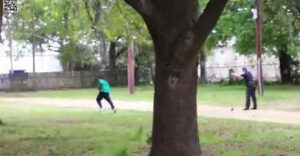 While the police are supposed to protect and serve, there are grave concerns about policing in America. Back in 2015, Patrolman Michael Thomas Slager shot Walter Lamer Scott to death after what should have been a routine traffic stop. While the video does not show what happened before Scott started to flee, it shows Scott was no threat to Slager: he was unarmed and running away. The video also shows Slager dropping an object by Scott’s body, what appears to be Slager’s Taser. When Slager called in the incident, he described it as a justifiable shooting: he claimed Scott grabbed his Taser and he had to use his service weapon. Obviously Slager was unaware that he was being recorded as he shot the fleeing Scott.
While the police are supposed to protect and serve, there are grave concerns about policing in America. Back in 2015, Patrolman Michael Thomas Slager shot Walter Lamer Scott to death after what should have been a routine traffic stop. While the video does not show what happened before Scott started to flee, it shows Scott was no threat to Slager: he was unarmed and running away. The video also shows Slager dropping an object by Scott’s body, what appears to be Slager’s Taser. When Slager called in the incident, he described it as a justifiable shooting: he claimed Scott grabbed his Taser and he had to use his service weapon. Obviously Slager was unaware that he was being recorded as he shot the fleeing Scott.
As I am friends with former and current law enforcement personnel, I know there are good officers. As such, I will not offer a sweeping condemnation of all police. However, this incident raised concerns about policing in the United States.
What made this incident unusual is not that a situation involving a black man and white officer escalated. It is also not very unusual that a black man was shot by a police officer. What was unusual at the time was that it was videotaped and the public got to see what happened, as opposed to what was claimed by the officer. If the incident had not been recorded, this would have bene just another case of a suspect attacking a police officer and being shot in self-defense. The recording, however, transformed it from the usual to the unusual: a police officer being charged with murder for shooting a suspect.
Since I teach critical thinking, I understand that the story of one incident, however vivid, is just an anecdote. I am also aware that to generalize from one incident is to commit the fallacy of hasty generalization. That said, the videotape provided grounds for being suspicious of other incidents in which suspects have been shot while (allegedly) trying to attack an officer. Since we know that it has happened, we know that it can happen. The obvious and important concern is the extent to which this sort of thing has happened and is still happening. That is, what needs to be determined is the extent to which officers have engaged in legitimate self-defense and to what extent officers have gotten away with murder.
This videotape showed, rather dramatically, that requiring police to use body cameras can be a good idea. People are somewhat less likely to act badly if they know they are being recorded. There is also the fact that there can be evidence of misdeeds. Cameras can sometimes benefit officers as video evidence might show when the use of force was legitimate.
What was also usual about this incident is that there was intense focus on the fact that Scott had a criminal record and legal troubles involving child support. This was part of the usual strategy of trying to show that the victim of a police shooting was “no angel” and perhaps to suggest that the shooting was, in some manner, justified. Or, at the very least, not as bad as one might think. However, Scott’s background had no relevance in this incident: his past legal troubles did not justify the shooting.
What was also usual was the reaction of Bill O’Reilly and some of the other fine folks at Fox, which I learned about back in 2015 from Professor Don Hubin’s reaction and criticism. Rather than focusing on the awfulness of the killing and what it suggests about other incidents, O’Reilly’s was worried that some people might use the killing to “further inflame racial tensions” and he added that “there doesn’t seem to be, as some would have you believe, that police are trying to hunt down black men and take their lives.” While this is not a claim that has been seriously put forth, O’Reilly endeavored to “prove” his claim by engaging in a misleading comparison.
He noted that “In 2012, last stats available, 123 blacks were killed by police 326 whites were killed.” While this shows that police kill more whites than blacks in total numbers, the comparison is misleading because O’Reilly leaves out a critical piece of information: the population at the time was about 77% white and about 13% black. This sheds a rather different light on O’Reilly’s statistics: they are accurate, yet misleading. In total numbers, more whites than blacks were killed by police. But blacks were killed at a disproportionately higher rate.
This point is usually countered by the claim that blacks commit more crimes than whites and thus it is no surprise that they get shot more often than whites. After all, one might point out, Scott did have a criminal record. This reply has a certain irony to it. After all, people who claim that blacks are arrested (and shot) at a disproportionate level claim that the police are more likely to arrest blacks than whites and focus more on policing blacks. As evidence that blacks commit more crimes, they point to the fact that blacks are more likely (adjusting for proportions) than whites to be arrested. While one would obviously expect more blacks to be arrested if they committed more crimes (proportionally), to assume what is in doubt (that policing is fair) as evidence that it should not be doubted is circular reasoning.
O’Reilly also used another stock defense: “You can’t … you can’t be a perfect system. There are going to be bad police officers; they’re going to make mistakes; um .. and then the mistakes are going to be on national television.” O’Reilly is using the perfectionist fallacy: the system cannot be perfect (which is true), therefore (he infers) we should not be concerned that this could be evidence of systematic problems. Or perhaps he just means that in an imperfect system one must expect mistakes such as an officer shooting a fleeing suspect. O’Reilly was also concerned that the mistakes would be on television. perhaps his concern was that people would fall victim to a hasty generalization from the misleading vividness of the incident. That would be a fair point if he operated in good faith. However, the message O’Reilly seemed to conveying is that this incident was an isolated one that does not indicate a systemic problem. Even though these “isolated” incidents happen with terrible regularity.
I will close by noting that my objective is not to attack the police. Rather, my concern is that the justice system should be just. It should also be important to all Americans, after all, most of us pledged allegiance to a nation that is supposed to offers liberty and justice to all.

 Back in 2018, President Trump
Back in 2018, President Trump  My name is Dr. Michael LaBossiere, and I am reaching out to you on behalf of the CyberPolicy Institute at Florida A&M University (FAMU). Our team of professors, who are fellows with the Institute, have developed a short survey aimed at gathering insights from professionals like yourself in the IT and healthcare sectors regarding healthcare cybersecurity.
My name is Dr. Michael LaBossiere, and I am reaching out to you on behalf of the CyberPolicy Institute at Florida A&M University (FAMU). Our team of professors, who are fellows with the Institute, have developed a short survey aimed at gathering insights from professionals like yourself in the IT and healthcare sectors regarding healthcare cybersecurity. Some states have passed or are considering laws that would restrict what government aid can be used to purchase. One apparently pro-active approach, taken by my adopted state of Florida, has been to weed out drug users by requiring recipients of aid
Some states have passed or are considering laws that would restrict what government aid can be used to purchase. One apparently pro-active approach, taken by my adopted state of Florida, has been to weed out drug users by requiring recipients of aid  While assessment is embedded into the body of education, when it first appeared I thought it would be another fading academic. When it first appeared, a modified version of the classic insult against teachers sprung to mind: “those who can do; those who can’t do teach; those who can’t teach assess.” In those early days, most professors saw assessment as a scam: assessment “experts” getting well-paying positions or consulting gigs and then dumping the tedious work on professors. Wily professors responded by making up assessment data and found no difference between the effectiveness of their fictional data and real data. This was because they were both ineffective. I, like many professors, found myself in brave new world of assessment.
While assessment is embedded into the body of education, when it first appeared I thought it would be another fading academic. When it first appeared, a modified version of the classic insult against teachers sprung to mind: “those who can do; those who can’t do teach; those who can’t teach assess.” In those early days, most professors saw assessment as a scam: assessment “experts” getting well-paying positions or consulting gigs and then dumping the tedious work on professors. Wily professors responded by making up assessment data and found no difference between the effectiveness of their fictional data and real data. This was because they were both ineffective. I, like many professors, found myself in brave new world of assessment. When the survivors of the Parkland school shooting started speaking against gun violence, conspiracy theorists launched the theory
When the survivors of the Parkland school shooting started speaking against gun violence, conspiracy theorists launched the theory  People try to make sense of events by weaving narratives matching their world views. One awful example of this is when people claim school shootings are false flag attacks. In this context, a false flag attack is when the attack is claimed to have been conducted by a mysterious force (like the deep state) to advance some political goal (such as taking away guns). In some cases, the false flag is alleged to be entirely false: there was no attack. In other cases, it is claimed there was a real attack, but attackers were acting at the behest (wittingly or not) of this mysterious force.
People try to make sense of events by weaving narratives matching their world views. One awful example of this is when people claim school shootings are false flag attacks. In this context, a false flag attack is when the attack is claimed to have been conducted by a mysterious force (like the deep state) to advance some political goal (such as taking away guns). In some cases, the false flag is alleged to be entirely false: there was no attack. In other cases, it is claimed there was a real attack, but attackers were acting at the behest (wittingly or not) of this mysterious force. Proponents of unions advance the classic free-rider argument for compelling non-union employees to share in the cost of collective bargaining. Public unions are usually legally required to provide services to non-member employees. Because of this, if employees did not pay fees to offset the costs of these benefits, then they would be exploiting the people who did pay. This would effectively be stealing. This argument is morally compelling, and this can be illustrated by an analogy.
Proponents of unions advance the classic free-rider argument for compelling non-union employees to share in the cost of collective bargaining. Public unions are usually legally required to provide services to non-member employees. Because of this, if employees did not pay fees to offset the costs of these benefits, then they would be exploiting the people who did pay. This would effectively be stealing. This argument is morally compelling, and this can be illustrated by an analogy. While public employees are usually not required to join unions, they are often required to help cover the cost of collective bargaining. While the legal issue will be settled by money and judges, there is the moral issue of whether public employees should be compelled to pay these fees. As a disclosure, I belong to a teachers’ union and this should be considered a potentially biasing factor.
While public employees are usually not required to join unions, they are often required to help cover the cost of collective bargaining. While the legal issue will be settled by money and judges, there is the moral issue of whether public employees should be compelled to pay these fees. As a disclosure, I belong to a teachers’ union and this should be considered a potentially biasing factor.